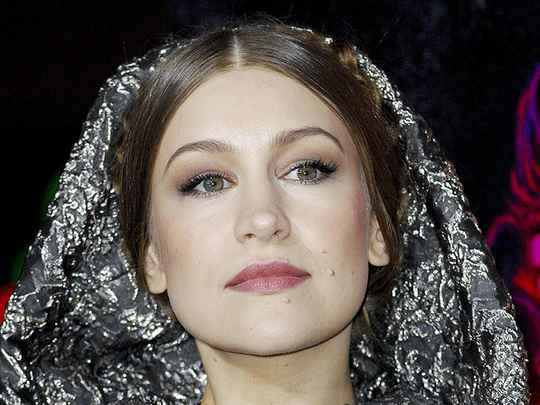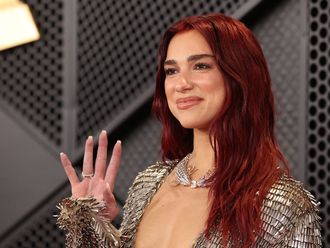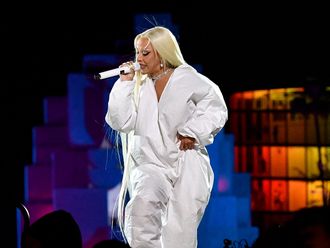
Joanna Newsom will issue her fourth album, Divers, on Friday, and since releasing her previous one in 2010 she’s experienced a series of life changes.
Five years ago, she’d already collaborated with Van Dyke Parks and performed at Walt Disney Concert Hall but had yet to appear as narrator and actress in Paul Thomas Anderson’s film Inherent Vice. She’d jumped homes from Nevada City, California, to New York City, where she drew inspiration for Divers from the city’s kaleidoscopic back story.
Newsom recently relocated to Los Angeles to make a home with her husband, comic actor Andy Samberg, at a place called Moorcrest. A grandly peculiar, mosaic-filled home in Hollywood Hills, its former occupants include movie star Mary Astor and actor-director Charlie Chaplin.
She spent four years working on Divers, a work so lyrical and precisely rendered that Hollywood obligations and a Disney-esque mansion seem like passing concerns. Carrying its own cinematic grandeur, the album’s 11 songs feature characters both historic and fictional, including Private Poorwill, King Tamanend and a military brigade called the 101st Lightborne Elite. The footnotable references and labyrinthine lines are presented in a package, in which every syllable is sacred, each note filled with a sense of the possible. Focused listening is rewarded.
She described the setting of Divers as “a place where history and humanity is concentrated and layered.” It sounds like the city, but jumps through time and space.
Combined, said Newsom, the overarching set of connections that built Divers asserted itself not long after she started writing for the album. “I started realising that I was returning to the same collection of ideas over and over again, narratively, and I was approaching them in different ways,” she said over lunch near Fountain Avenue and L. Ron Hubbard Drive.
“This song, I might be approaching the set of ideas in a fantastical way, and in that song, I might be approaching them in a very straightforward way. This one I might be approaching them from a first-person or autobiographical perspective, and this song I might be approaching them from a much more sort of zoomed-out, almost disembodied, omniscient narrative perspective.
“I started to feel that all the songs were connected in that way,” she added. “Almost that they were all asking the same question.”
At the musical centre of Divers are Newsom’s primary instruments, the harp and her soaring voice, which are augmented at various times with electric guitar, piano, drum kit, bouzouki, trombone, violin, musical saw or, in the case of Time, As a Symptom, the City of Prague Philharmonic Orchestra. Newsom expanded her own instrumentation to include the clavichord, harpsichord and Mellotron. In a new twist, she also added classic synthesisers and immersed herself with engineer Noah Georgeson in the art of mixing the album’s many frequencies into a sonically cohesive whole. It was recorded by Georgeson and Steve Albini.
“I think I had the sense that this was an album that was going to become itself in the mix — that there were so many disparate elements and strange sort of piles of options that had accumulated, not all of which would have ended up being useful,” she said.
This whirlwind of creative curiosity is partially what drew the contemporary composer-arranger Nico Muhly to collaborate with Newsom on the album’s first song, called Anecdotes. Noting what he called her fearlessness, Muhly (best known to the general public for his work on films including Margaret and The Reader) described Newsom in an email as “a mistress of structure and of governing time; the listener feels on a journey with a responsible guide.”
Take the second song on Divers, called Sapokanikan, the original name for what is now Greenwich Village.
Musically, the piece mixes Brecht with the Baroque, hinting at Hejira-era Joni Mitchell. Opening with a gentle, timeless tangle of piano and snare drum, the song defiantly avoids the contemporary, dotting through decades with each measure as lyrics reference Tammany Hall, hunters of the future and a mysterious woman named Florry Walker. It approaches bombast but retreats, moves into a drunken waltz and spins in circles as Newsom harmonises with herself before finishing in a different musical environment entirely after just over five minutes. It’s all very studied and cosmopolitan, which makes sense.
“New York was useful as sort of a case study for some of the things that I wanted to talk about,” said Newsom. “There’s a lot of binary stuff on the record — pulling.” She describes what she called “obvious boldface” themes such as “time, space, life, death, but a lot of the songs are occupying or trying to cross the border between those two opposing forces, and I feel like the idea of the city, which in some songs is named — New York — and in others songs is not named, is sort of a character.”
Newsom, 33, sublimely articulate about her tastes and approaches, was born and raised in Nevada City, one of three children in a family whose distant relation is Lt. Gov. Gavin Newsom. She knew she wanted to be a professional musician at an early age and gravitated toward the most unwieldy of instruments, the harp, while also studying piano. After studying composition at Mills College in Northern California and recording two early EPs, the artist signed to the respected Chicago label Drag City, which over the years has been home to iconoclastic artists including Will Oldham, Jennifer Herrema and Pavement. Her 2004 first album, The Milk-Eyed Mender, marked the arrival of a similarly inventive and equally uncommercial voice.
It was around this time that Muhly first saw Newsom perform, at the Bowery Ballroom in New York. “My roommate and I had arrived early, and Joanna wheeled her harp out and started singing Bridges and Balloons,” he recalled. “We were mesmerised and basically dumbstruck about how great and weird and genius the whole thing was.”
Detractors tend to focus more on that weirdness. Those looking for Beatles-esque verse-chorus-verse resolution, for example, are in for some trouble. Her lyrics seem written not only to be sung but also to work on the page, and she’s more than willing to sacrifice singalong ease for expository conceits. Lines are stitched together with an expert’s hand, then brought to life through a confident voice that can reach and hold notes one moment and squawk the next.
Newsom moved further from pop structures on her second album, Ys, an angular, challenging work produced and arranged in collaboration with Parks that confirmed her promise. Its success carried her away from smoky clubs into concert halls, including a memorable performance at Disney Hall in 2007.
Divers is no less challenging than either Ys or 2010s Have One on Me. But it is, said Newsom, the most thematically linked album she’s done, even if narrative strands are hardly chronological. Rather, Newsom describes the work as “a sort of narrative loop.”
“Each song is running a leg of the relay and then passing the baton to the next song, but they’re all ultimately circumnavigating something.”
Unlocking the album’s secrets, like all of Newsom’s work, requires intentional listening. She returns, though, to the notion of time, the ways in which it interacts with a plot of land and the people who inhabit it. In typically descriptive language she calls these souls “stuck together and squashed together, living and dying and making noise and smelling weird and falling in love, creating beauty and fighting with each other and all that. It’s so saturated there.”
The same could be said for the immersive Divers.













